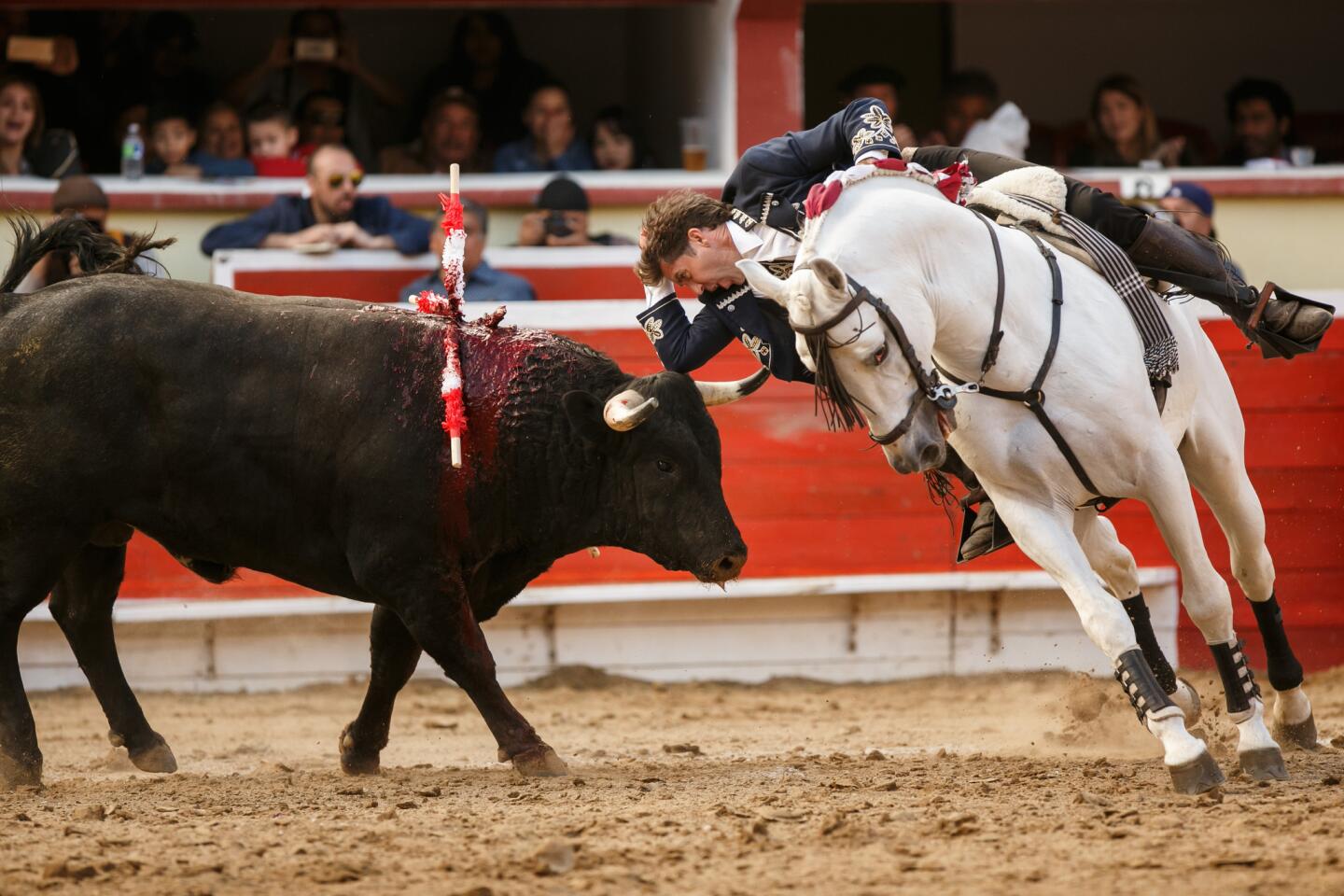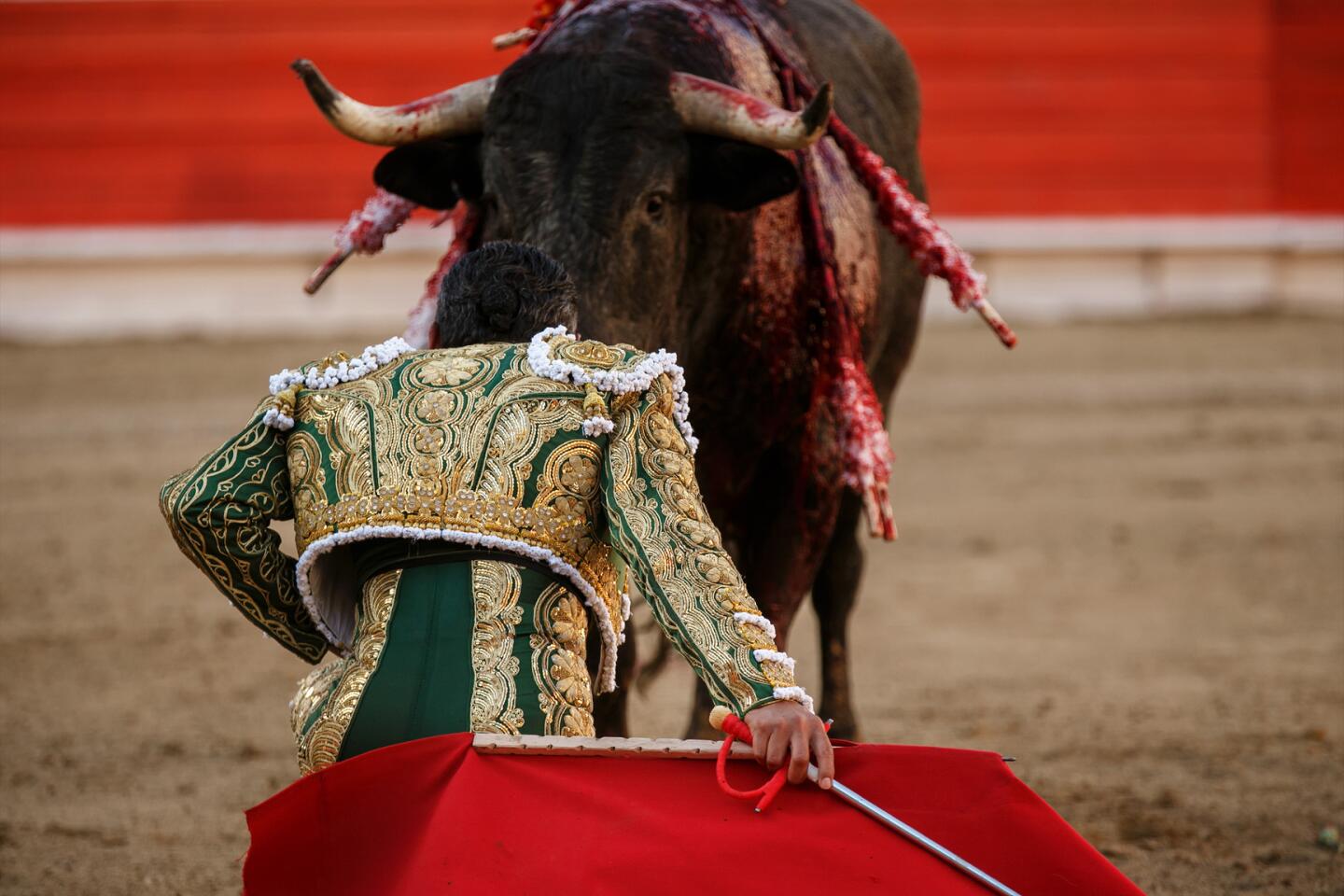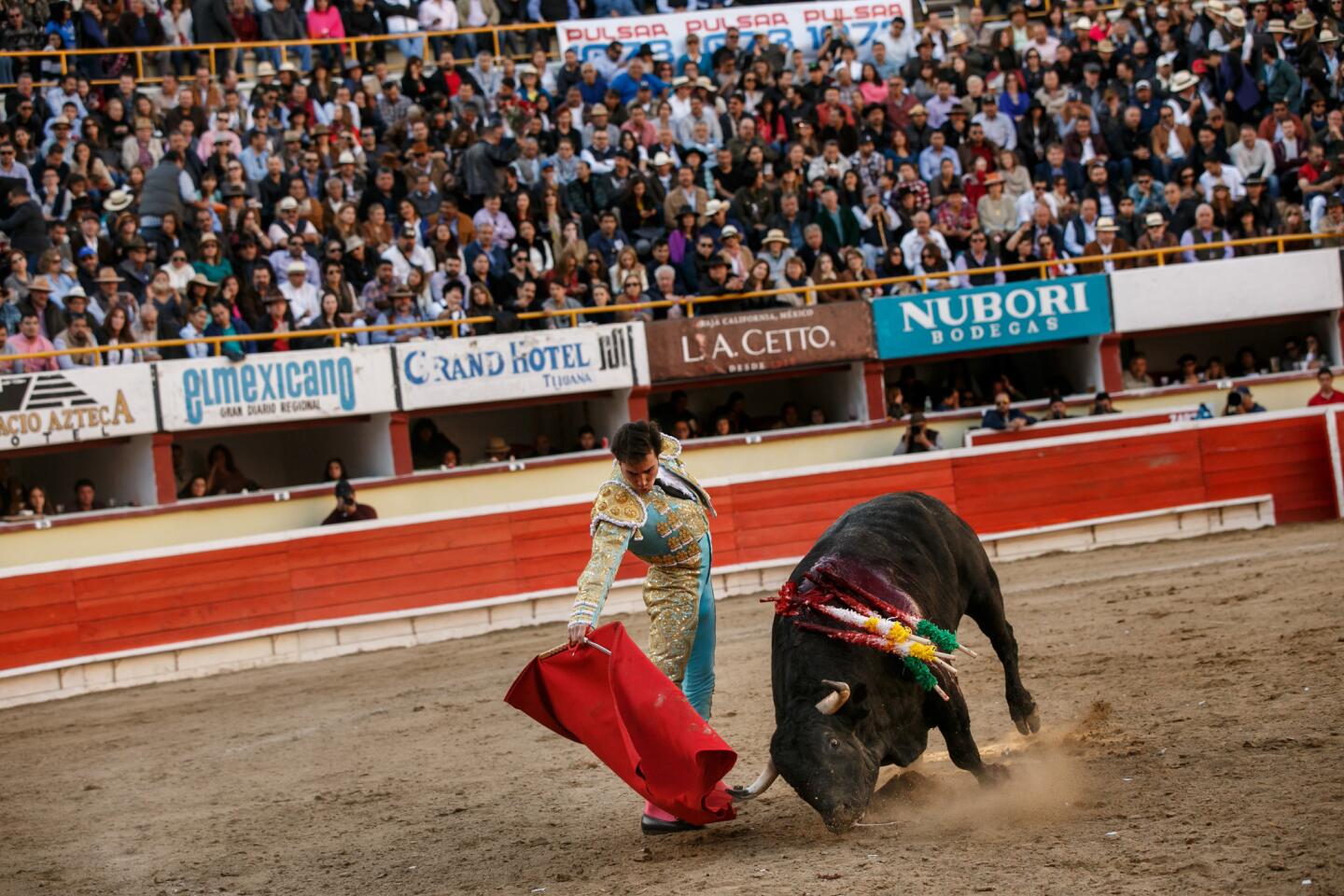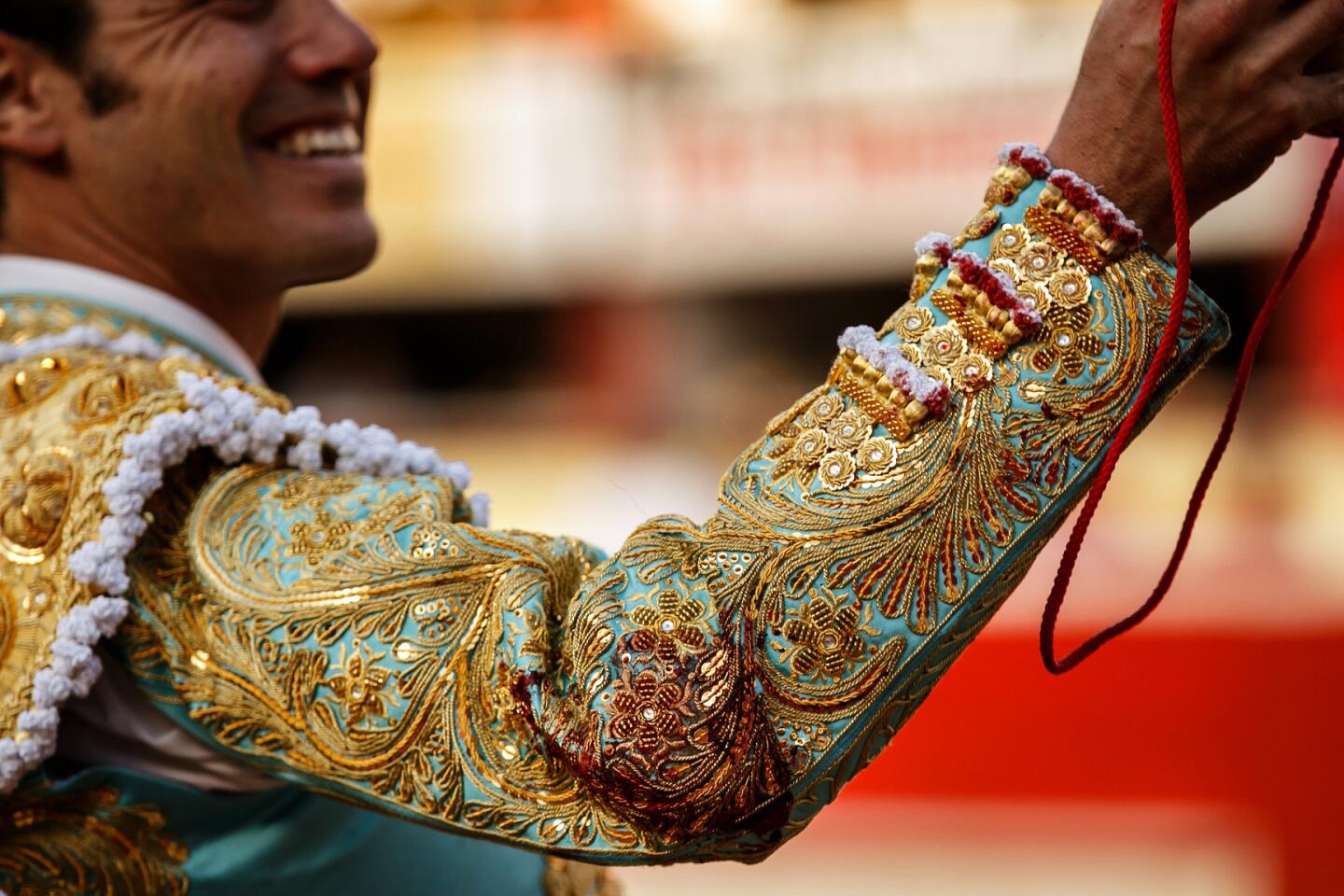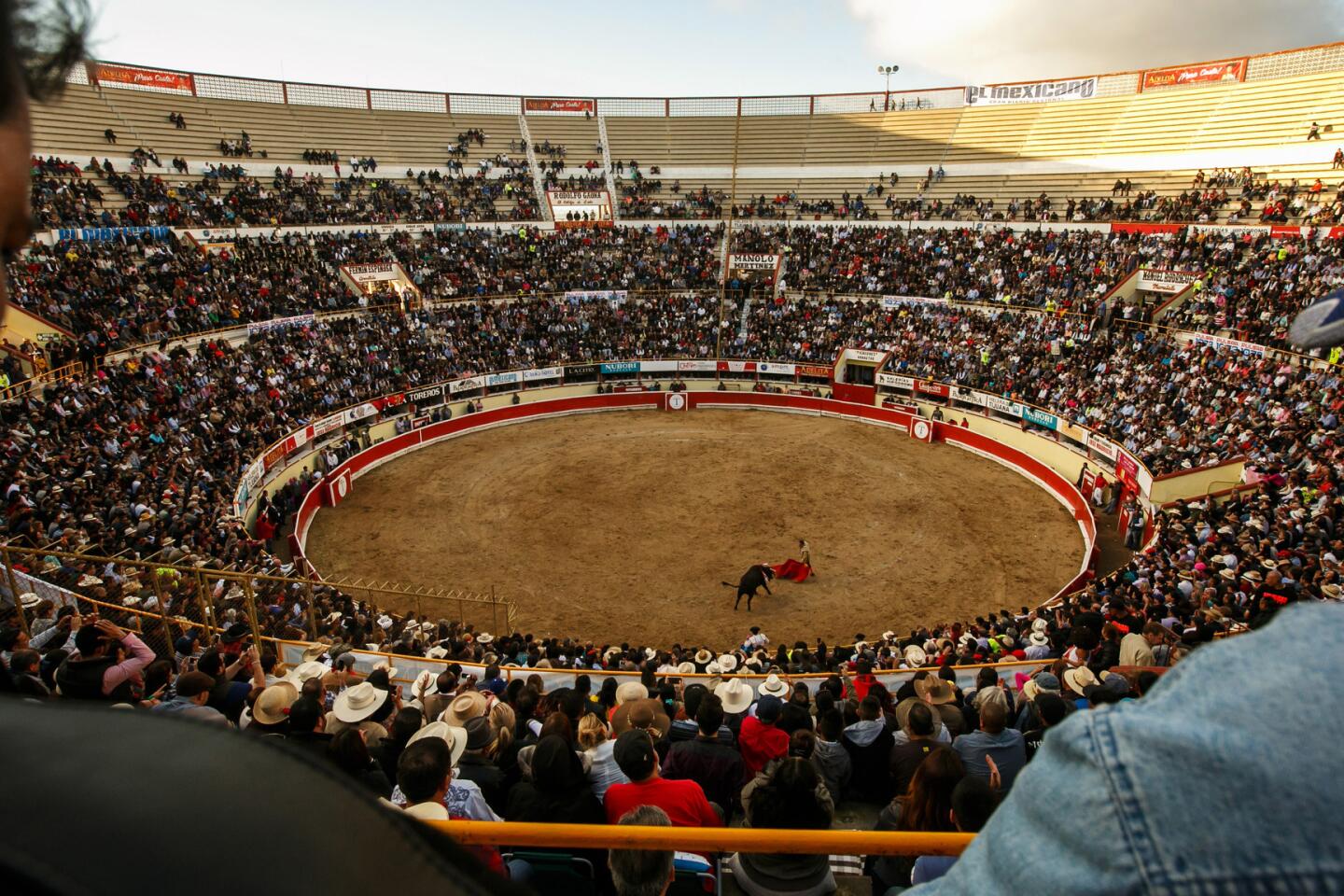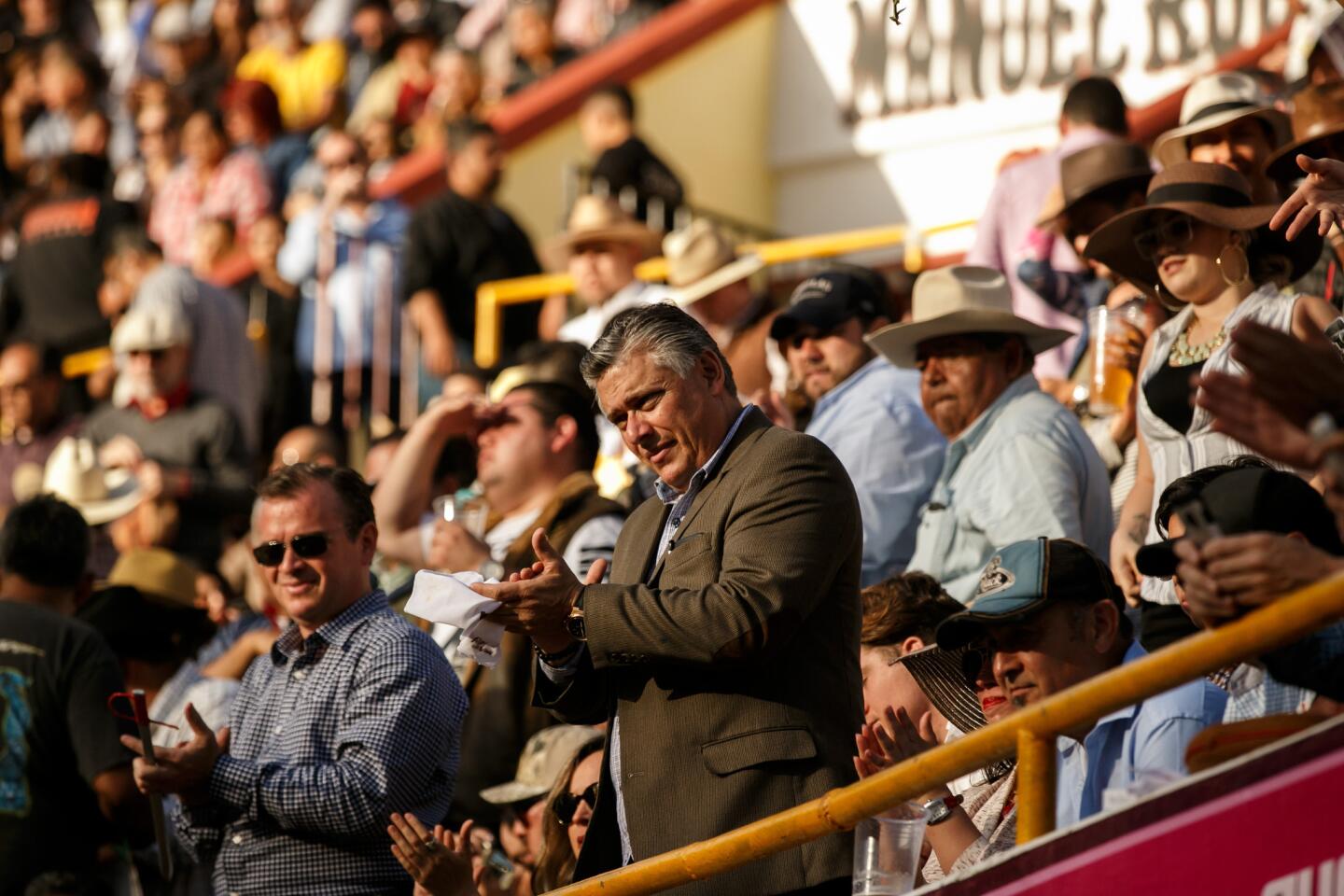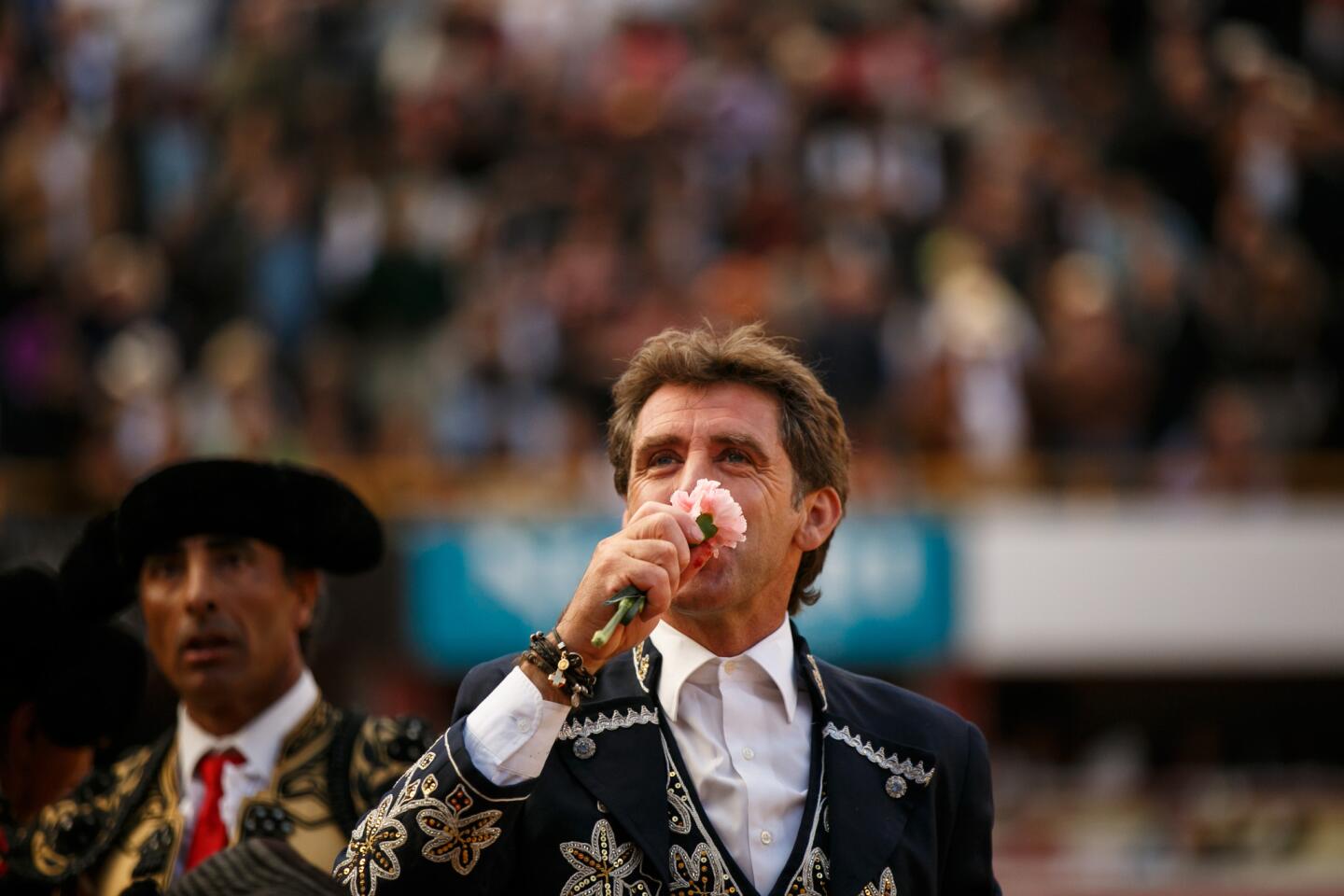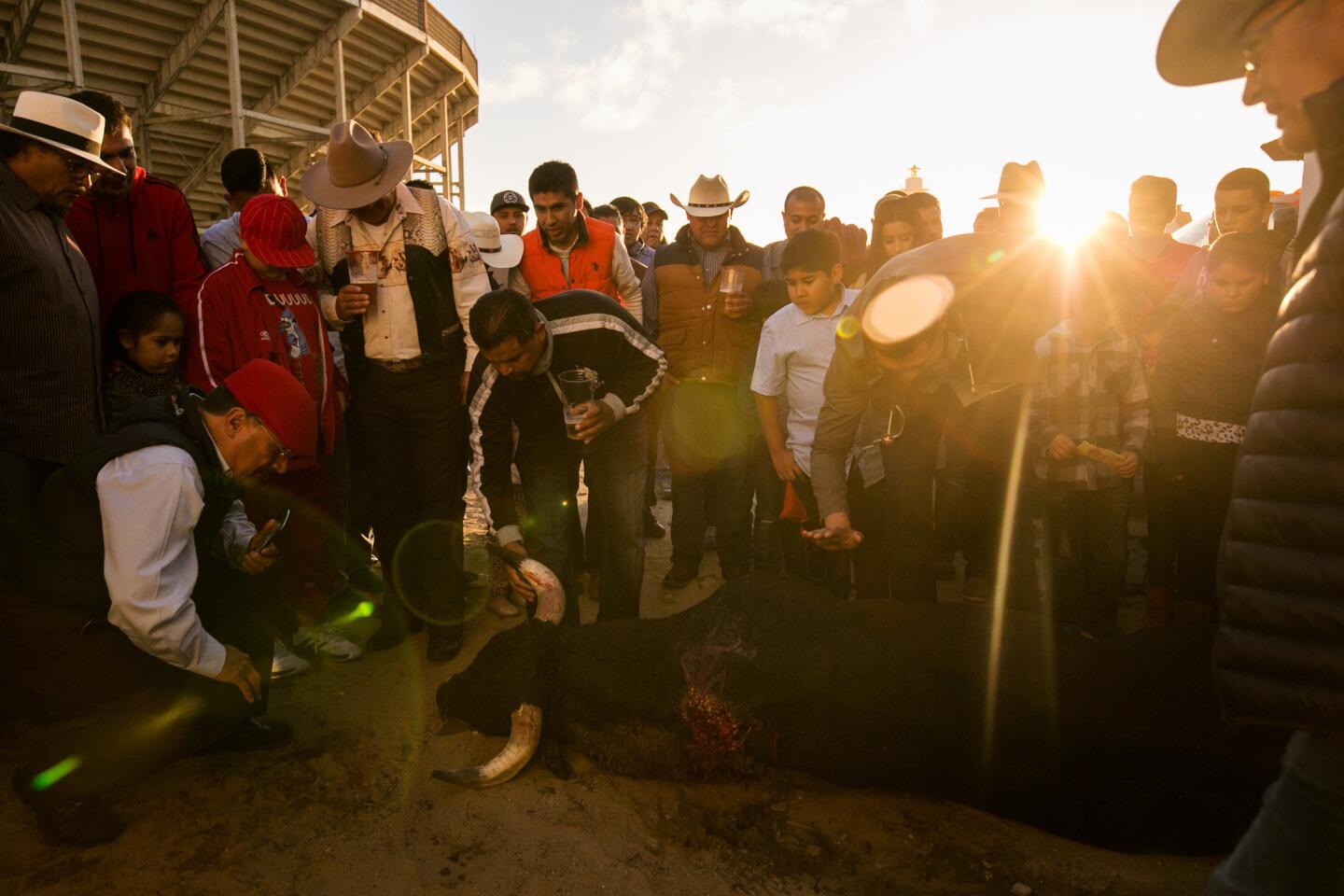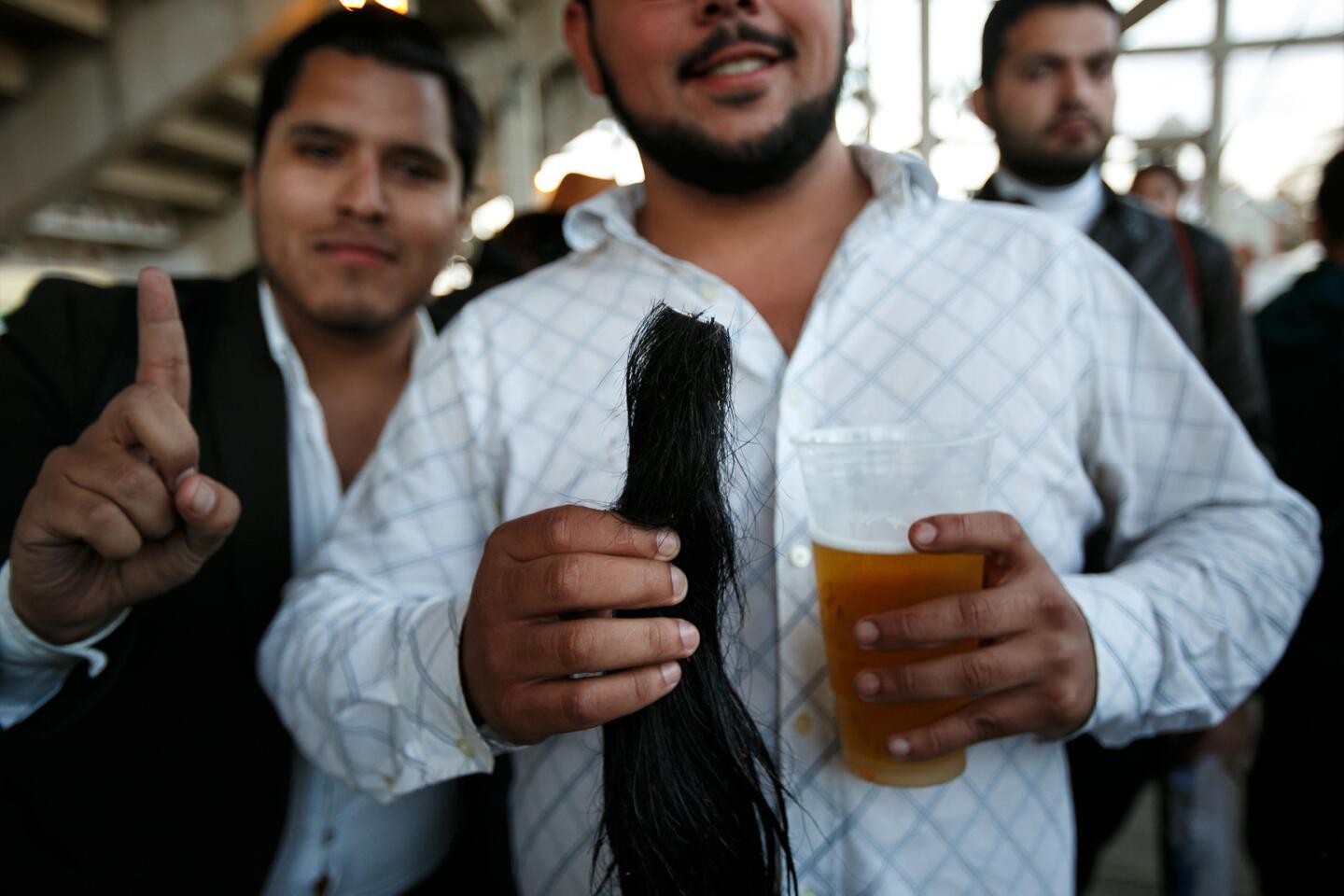As Baja resumes bullfighting, Mexicans debate: Is it an art form or a cruel, outdated ritual?

Baja California lawmakers recently postponed a vote that would have banned bullfighting.
- Share via
Reporting from Tijuana — Just before 4 p.m. Sunday, with sunshine filling the stadium and a gentle breeze wafting off the Pacific Ocean just a few hundred yards away, the chant begins.
“To-ro! To-ro! To-ro!” They are calling for the bull.
It has been months since the last bullfight, which many believe should have been the last bullfight ever. Just three days before, Baja California’s congress — its state legislature — postponed a vote that would have banned bullfighting in the Mexican state and forced the cancellation of this spectacle.
The crowd is restless.
Ever greater numbers of Mexicans see this as a cruel and outdated ritual. Polls show that roughly 80% of Baja Californians oppose it. But as the bullfighting season opened on schedule Sunday, the dwindling ranks of traditionalists could savor at least a temporary victory and another day of what, they insist, is an art form.
Trumpets sound from a band on the third level of the stadium. The crowd erupts. From a tunnel walk four young men in glittering, neon-colored skintight outfits. The crowd continues to cheer warily — the talent of these younger men can vary, though they are soon successfully goading a young bull named Galan into chasing them.
Part rodeo, part derby and part tailgate, the Tijuana bullfights are an amalgam of Mexican society in the borderlands. Ranchers in wide-brimmed hats coax their wives in jean jackets through the busy gates outside the stadium, divided between Sombra (shade) and Sol (seats in the sun).
Inside, young men in flannel shirts cluster next to society women in gowns and extravagant hats or with flowers in their hair. There are very few children, despite free admission to those younger than 12.
A sign in front of the stadium reads “Pablo Hermoso de Mendoza” in giant red-and-white letters. Pictured is a man on horseback, with a navy coat and silver trim. He is astride a horse and he is considered the best in the world at what he does — namely, killing bulls while astride a horse, forcing him to control his horse and the bull at the same time.
But first, the young men must face Galan, a large, muscular and not especially aggressive bull.
The men leap head-first over the charging animal; the crowd swoons. The men wave capes at him and, when he charges, they run behind red barriers or, in a few breathless instances, allow the bull to nearly strike them before sliding out of the way at the last perceptible second. When they’re not actively engaging him, Galan stands peacefully, waving his tail.
Eventually, he tires. Froth foams at the tips of his mouth and his tongue lolls along his lower lip. He has kicked back dirt and charged 10, 20, 30 times this afternoon. Somewhere, a decision is made, and the four men in neon outfits kneel down while the bull remains standing. It’s over.
Galan runs back to the bull tunnel, untouched. The crowd claps and throws roses to the young men.
The arena clears. Three men in yellow with pink capes emerge from gaps in the wall of the arena.
Then the man in navy blue-and-silver, Pablo Hermoso de Mendoza, appears, and the crowd cheers lustily.
Mendoza is a rejoneador, a matador who fights from horseback. His picture illustrates the Wikipedia entry for rejoneadors.
Bullfighters would starve if every bull were like the docile Galan. But there is no wait for Mendoza’s opponent. Out of the gates charges a bull weighing 1,179 pounds.
His name is Pedrin.
::
Ruben Urenda, 69, started at the bullfights when he was 18, when Tijuana was far smaller but had two bullfighting rings. One closed in 2000, but the one that still stands is a grand old stone arena, the Plaza de Toros Monumental de Tijuana, built in a corner of the city where Mexico meets the U.S. border to the north and the sea to the west.
Urenda and all other stadium staff are part of a union of food workers in Tijuana who serve the bullring, as well as catered events, soccer games and private parties. He has worked his way up, from a simple beer vendor to a waiter, a coveted, well-paying job in which he wears a black vest over a white button-up shirt.
The stadium employs about 70 beer vendors, and hopeful fill-ins line up outside the morning of every bullfight. Urenda smiles at the memory. “I remember that. One hundred beers [was] a very good day.”
A man named Gerardo Mancillas passes in front of him with two children, ages 9 and 11, in tow. He drove them four hours from their home in Zacatecas to see the bullfight. Urenda motions to the children.
“They should see it and understand,” he says.
Then he hears the term “activist” and his face darkens.
There are no protesters here today, but bullfighting is under siege.
The Mexican states of Sonora and Coahuila, which also border the U.S., have banned bullfighting, as has the southern state of Guerrero. Even in Spain, where bullfighting reached its apex, protests are increasingly common.
I don’t like the blood. They harass the animals, mistreat them. Even after three years it’s difficult [for me] to watch. But I really need the money.
— Jessica Hernandez, a beer vendor at the bullfight arena
Baja’s congress has repeatedly considered a ban on bullfighting, but has put off a final decision. On Thursday, it did so again, saying the matter required further study.
At issue, from the state’s point of view, is the economic draw of bullfights, which pull in Mexicans from surrounding regions and Americans who cross the border from San Diego.
At the same time, legislators are increasingly aware of animal rights activists who say there is no justification for a sport that amounts to torture.
Urenda, the waiter, insists that bullfighting it not primarily about killing a bull, but about the art with which it’s done.
“Everyone knows the bull is going to lose,” he says. “If they succeed in closing [the bullring], it will be because they don’t understand. I would lose my source of income, definitely. All the waiters, all the [beer] vendors. Seventy families would be left with nothing.”
Twenty feet away, Jessica Hernandez, 21, wishes the activists would finally shut down the bullfights so the food-workers union would relocate her. She’s been a beer vendor for three years at the bullfights.
“I don’t like the blood,” she said. “They harass the animals, mistreat them. Even after three years it’s difficult [for me] to watch. But I really need the money and this is what was open.”
::
It is afternoon, and Pedrin is bleeding.
Mendoza, the rejoneador, is on a black horse and has lanced him twice. A wound in Pedrin’s right shoulder is shallow, but his left shoulder has begun to drip red down his back.
Mendoza’s job on the black horse is to weaken the bull’s neck muscles by stabbing the animal in the mound of muscle behind his neck. The lances force Pedrin to charge with his neck lowered, which will help Mendoza to aim and deliver blows. Two spears dangle from Pedrin’s shoulders. More will follow.
Mendoza briefly leaves the arena and returns, in his glittering jacket, atop a white horse. Pedrin, black and gray and muscular, turns his attention to him.
Mendoza rides his horse directly toward the bull, then veers. The crowd cheers, but this is simply the warmup.
Pedrin follows the horse, bucking his neck, trying to strike the animal’s flank. He pulls close and the horse kicks Pedrin in the face. The crowd cheers and laughs.
Mendoza delivers another lance to Pedrin’s flank. The bull doesn’t slow.
“Aiyeee!” shouts a woman in the first row, close enough to smell the bull.
The blood has begun to flood out of Pedrin’s shoulder and down to his flank, thick wet rivulets pouring over black fur already wet and matted with blood.
Mendoza reins his horse into a small dance near the bull, the horse taking short steps forward and back while the bull tries to gore it. This is the closest he has taken the horse to the bull, and the crowd laps it up.
Pedrin is slowing. His neck is bowed and his charges aren’t as quick, but he still has designs on Mendoza and his horse. The rejoneador grins. He circles the arena, waving his black cap, as Pedrin watches him warily from its center.
Mendoza approaches the bull and lances it again, then once more. The bull bucks and kicks but continues to charge.
Mendoza dismounts and approaches. The men in yellow with pink capes draw closer. A short, mustachioed man in a small black cap walks behind the bull.
Pedrin stares straight ahead at the rejoneador, who lifts his arms and walks closer.
Suddenly, Pedrin kneels down. The crowd stands and cheers. The bull is finished.
Mendoza bows.
The man with the mustache and small black cap strides up behind the bull. He pulls out a knife with a half-foot blade and draws it and stabs the bull once in the back of the head to sever the spine and then stabs the bull again in the same spot and wipes it carelessly on the bull’s right flank.
Pedrin rolls onto his right side. His back legs kick twice and he is still.
See more of our top stories on Facebook >>
Follow @NigelDuara for news from the border.
ALSO
Judge rules against China’s first-ever same-sex marriage case
After Chibok, another Boko Haram kidnapping of Nigerian children was met with silence
Kerry, in L.A., touts Pacific trade deal as vital to Hollywood, Silicon Valley
More to Read
Sign up for Essential California
The most important California stories and recommendations in your inbox every morning.
You may occasionally receive promotional content from the Los Angeles Times.
